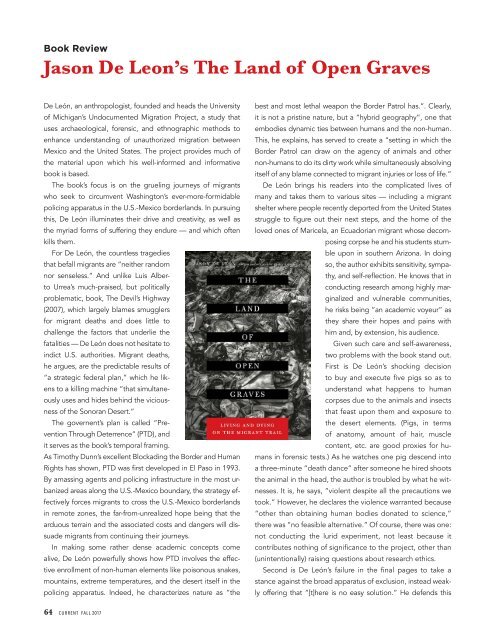Current Magazine
You also want an ePaper? Increase the reach of your titles
YUMPU automatically turns print PDFs into web optimized ePapers that Google loves.
Book Review<br />
Jason De Leon’s The Land of Open Graves<br />
De León, an anthropologist, founded and heads the University<br />
of Michigan’s Undocumented Migration Project, a study that<br />
uses archaeological, forensic, and ethnographic methods to<br />
enhance understanding of unauthorized migration between<br />
Mexico and the United States. The project provides much of<br />
the material upon which his well-informed and informative<br />
book is based.<br />
The book’s focus is on the grueling journeys of migrants<br />
who seek to circumvent Washington’s ever-more-formidable<br />
policing apparatus in the U.S.-Mexico borderlands. In pursuing<br />
this, De León illuminates their drive and creativity, as well as<br />
the myriad forms of suffering they endure — and which often<br />
kills them.<br />
For De León, the countless tragedies<br />
that befall migrants are “neither random<br />
nor senseless.” And unlike Luis Alberto<br />
Urrea’s much-praised, but politically<br />
problematic, book, The Devil’s Highway<br />
(2007), which largely blames smugglers<br />
for migrant deaths and does little to<br />
challenge the factors that underlie the<br />
fatalities — De León does not hesitate to<br />
indict U.S. authorities. Migrant deaths,<br />
he argues, are the predictable results of<br />
“a strategic federal plan,” which he likens<br />
to a killing machine “that simultaneously<br />
uses and hides behind the viciousness<br />
of the Sonoran Desert.”<br />
The governent’s plan is called “Prevention<br />
Through Deterrence” (PTD), and<br />
it serves as the book’s temporal framing.<br />
As Timothy Dunn’s excellent Blockading the Border and Human<br />
Rights has shown, PTD was first developed in El Paso in 1993.<br />
By amassing agents and policing infrastructure in the most urbanized<br />
areas along the U.S.-Mexico boundary, the strategy effectively<br />
forces migrants to cross the U.S.-Mexico borderlands<br />
in remote zones, the far-from-unrealized hope being that the<br />
arduous terrain and the associated costs and dangers will dissuade<br />
migrants from continuing their journeys.<br />
In making some rather dense academic concepts come<br />
alive, De León powerfully shows how PTD involves the effective<br />
enrollment of non-human elements like poisonous snakes,<br />
mountains, extreme temperatures, and the desert itself in the<br />
policing apparatus. Indeed, he characterizes nature as “the<br />
best and most lethal weapon the Border Patrol has.”. Clearly,<br />
it is not a pristine nature, but a “hybrid geography”, one that<br />
embodies dynamic ties between humans and the non-human.<br />
This, he explains, has served to create a “setting in which the<br />
Border Patrol can draw on the agency of animals and other<br />
non-humans to do its dirty work while simultaneously absolving<br />
itself of any blame connected to migrant injuries or loss of life.”<br />
De León brings his readers into the complicated lives of<br />
many and takes them to various sites — including a migrant<br />
shelter where people recently deported from the United States<br />
struggle to figure out their next steps, and the home of the<br />
loved ones of Maricela, an Ecuadorian migrant whose decomposing<br />
corpse he and his students stumble<br />
upon in southern Arizona. In doing<br />
so, the author exhibits sensitivity, sympathy,<br />
and self-reflection. He knows that in<br />
conducting research among highly marginalized<br />
and vulnerable communities,<br />
he risks being “an academic voyeur” as<br />
they share their hopes and pains with<br />
him and, by extension, his audience.<br />
Given such care and self-awareness,<br />
two problems with the book stand out.<br />
First is De León’s shocking decision<br />
to buy and execute five pigs so as to<br />
understand what happens to human<br />
corpses due to the animals and insects<br />
that feast upon them and exposure to<br />
the desert elements. (Pigs, in terms<br />
of anatomy, amount of hair, muscle<br />
content, etc. are good proxies for humans<br />
in forensic tests.) As he watches one pig descend into<br />
a three-minute “death dance” after someone he hired shoots<br />
the animal in the head, the author is troubled by what he witnesses.<br />
It is, he says, “violent despite all the precautions we<br />
took.” However, he declares the violence warranted because<br />
“other than obtaining human bodies donated to science,”<br />
there was “no feasible alternative.” Of course, there was one:<br />
not conducting the lurid experiment, not least because it<br />
contributes nothing of significance to the project, other than<br />
(unintentionally) raising questions about research ethics.<br />
Second is De León’s failure in the final pages to take a<br />
stance against the broad apparatus of exclusion, instead weakly<br />
offering that “[t]here is no easy solution.” He defends this<br />
64 CURRENT FALL 2017





